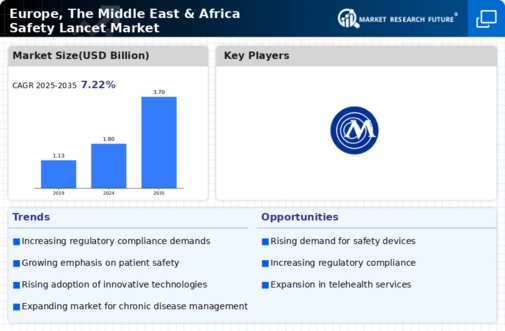Rising Incidence of Chronic Diseases
The increasing prevalence of chronic diseases in Europe, the Middle East, and Africa is a significant driver for the Safety Lancet Market. Conditions such as diabetes and cardiovascular diseases necessitate regular blood sampling, thereby increasing the demand for safety lancets. According to health statistics, the number of individuals diagnosed with diabetes in this region is projected to rise, leading to a corresponding increase in the need for safe blood glucose monitoring devices. This trend suggests that manufacturers may focus on developing specialized safety lancets tailored for chronic disease management. Consequently, the market is likely to witness sustained growth as healthcare providers seek to enhance patient care while minimizing risks associated with blood sampling.
Increased Awareness of Patient Safety
The growing awareness of patient safety is significantly influencing the Europe, The Middle East & Africa Safety Lancet Market. Healthcare professionals and patients alike are becoming more cognizant of the risks associated with traditional lancets, leading to a shift towards safer alternatives. Educational campaigns and initiatives by health organizations have highlighted the importance of using safety lancets to prevent needlestick injuries and infections. This heightened awareness is reflected in market data, which indicates a rising demand for safety lancets, particularly in outpatient settings and home healthcare. As patient safety continues to be a priority for healthcare systems, the market for safety lancets is expected to expand, driven by the need for safer medical practices.
Regulatory Influence on Safety Devices
Regulatory frameworks play a crucial role in shaping the Europe, The Middle East & Africa Safety Lancet Market. Stringent regulations imposed by health authorities ensure that safety lancets meet high standards of quality and efficacy. The European Medicines Agency and other regional bodies have established guidelines that manufacturers must adhere to, which include rigorous testing and validation processes. Compliance with these regulations not only enhances product safety but also fosters consumer trust. As a result, manufacturers are increasingly investing in research and development to align their products with regulatory expectations. This trend is likely to drive market growth, as adherence to regulations can lead to increased market access and competitive advantage.
Shift Towards Home Healthcare Solutions
The Europe, The Middle East & Africa Safety Lancet Market is also being propelled by a shift towards home healthcare solutions. As healthcare systems evolve, there is a growing emphasis on providing care in home settings, particularly for patients with chronic conditions. This trend has led to an increased demand for user-friendly safety lancets that can be utilized by patients or caregivers without extensive training. Market analysis indicates that the home healthcare segment is expected to grow significantly, driven by the convenience and accessibility it offers. Manufacturers are responding to this demand by designing safety lancets that are not only effective but also easy to use, thereby expanding their market reach and enhancing patient safety in home environments.
Technological Advancements in Safety Lancets
The Europe, The Middle East & Africa Safety Lancet Market is experiencing a notable transformation due to rapid technological advancements. Innovations in design and materials have led to the development of safety lancets that minimize the risk of needlestick injuries. For instance, the integration of automatic retractable mechanisms has enhanced user safety and comfort. Furthermore, advancements in manufacturing processes have improved the precision and reliability of these devices. According to recent data, the market for safety lancets in this region is projected to grow at a compound annual growth rate of approximately 6.5% over the next five years. This growth is indicative of the increasing demand for safer medical devices, driven by both healthcare providers and patients who prioritize safety in medical procedures.


















Leave a Comment